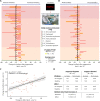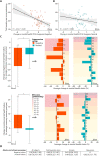Improving mental health by training the suppression of unwanted thoughts
- PMID: 37729415
- PMCID: PMC10511195
- DOI: 10.1126/sciadv.adh5292
Improving mental health by training the suppression of unwanted thoughts
Abstract
Anxiety, posttraumatic stress, and depression markedly increased worldwide during the COVID-19 pandemic. People with these conditions experience distressing intrusive thoughts, yet conventional therapies often urge them to avoid suppressing their thoughts because intrusions might rebound in intensity and frequency, worsening the disorders. In contrast, we hypothesized that training thought suppression would improve mental health. One hundred and twenty adults from 16 countries underwent 3 days of online training to suppress either fearful or neutral thoughts. No paradoxical increases in fears occurred. Instead, suppression reduced memory for suppressed fears and rendered them less vivid and anxiety provoking. After training, participants reported less anxiety, negative affect, and depression with the latter benefit persisting at 3 months. Participants high in trait anxiety and pandemic-related posttraumatic stress gained the largest and most durable mental health benefits. These findings challenge century-old wisdom that suppressing thoughts is maladaptive, offering an accessible approach to improving mental health.
Figures






Similar articles
-
A cross-national study of factors associated with women's perinatal mental health and wellbeing during the COVID-19 pandemic.PLoS One. 2021 Apr 21;16(4):e0249780. doi: 10.1371/journal.pone.0249780. eCollection 2021. PLoS One. 2021. PMID: 33882096 Free PMC article.
-
Controlling intrusive thoughts of future fears under stress.Neurobiol Stress. 2023 Nov 2;27:100582. doi: 10.1016/j.ynstr.2023.100582. eCollection 2023 Nov. Neurobiol Stress. 2023. PMID: 38025283 Free PMC article.
-
A comparison of thought suppression to an acceptance-based technique in the management of personal intrusive thoughts: a controlled evaluation.Behav Res Ther. 2005 Apr;43(4):433-45. doi: 10.1016/j.brat.2004.03.005. Behav Res Ther. 2005. PMID: 15701355 Clinical Trial.
-
A large-scale meta-analytic atlas of mental health problems prevalence during the COVID-19 early pandemic.J Med Virol. 2022 May;94(5):1935-1949. doi: 10.1002/jmv.27549. Epub 2022 Jan 9. J Med Virol. 2022. PMID: 34958144 Free PMC article.
-
The mental health impacts of the COVID-19 pandemic among individuals with depressive, anxiety, and stressor-related disorders: A scoping review.PLoS One. 2023 Dec 14;18(12):e0295496. doi: 10.1371/journal.pone.0295496. eCollection 2023. PLoS One. 2023. PMID: 38096173 Free PMC article.
Cited by
-
Emotional associative memory is disrupted by directed forgetting.Commun Psychol. 2023 Oct 10;1(1):24. doi: 10.1038/s44271-023-00024-x. Commun Psychol. 2023. PMID: 39242722 Free PMC article.
-
Neural correlates of suppressing and imagining future threat.Sci Rep. 2025 Mar 20;15(1):9574. doi: 10.1038/s41598-025-94580-3. Sci Rep. 2025. PMID: 40113972 Free PMC article.
-
Inhibitory control in addictive behaviors: is there room for memory suppression?Front Hum Neurosci. 2025 Jun 5;19:1545176. doi: 10.3389/fnhum.2025.1545176. eCollection 2025. Front Hum Neurosci. 2025. PMID: 40538593 Free PMC article. No abstract available.
-
How do the sleep features that characterise depression impact memory?Emerg Top Life Sci. 2023 Dec 22;7(5):499-512. doi: 10.1042/ETLS20230100. Emerg Top Life Sci. 2023. PMID: 38054537 Free PMC article. Review.
-
Neurobiology and systems biology of stress resilience.Physiol Rev. 2024 Jul 1;104(3):1205-1263. doi: 10.1152/physrev.00042.2023. Epub 2024 Mar 14. Physiol Rev. 2024. PMID: 38483288 Free PMC article. Review.
References
-
- S. Freud, Repression, in The Standard Edition of the Complete Psychological Works of Sigmund Freud, vol. XIV (1914–1916): On the History of the Psycho-Analytic Movement, Papers on Metapsychology and Other Works (Hogarth Press and the Institute of Psycho-Analysis, 1957); pp. 141–158.
-
- S. Freud, The Interpretation of Dreams (Hogarth Press, 1953).
-
- D. M. Wegner, Ironic processes of mental control. Psychol. Rev. 101, 34–52 (1994). - PubMed
-
- D. M. Wegner, How to think, say, or do precisely the worst thing for any occasion. Science 325, 48–50 (2009). - PubMed
-
- M. C. Anderson, K. N. Ochsner, B. Kuhl, J. Cooper, E. Robertson, S. W. Gabrieli, G. H. Glover, J. D. E. Gabrieli, Neural systems underlying the suppression of unwanted memories. Science 303, 232–235 (2004). - PubMed
MeSH terms
Grants and funding
LinkOut - more resources
Full Text Sources
Medical

